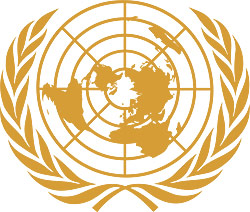
Unit 6: Modern World History
Lesson C: Research - Challenges of the Modern World
Lesson Overview

United Nations Emblem [1]
Globalization, political, economic, and cultural interconnectivity, began in the early modern period, but has continuously accelerated since 1945. Events of the second half of the 20th century, and beginning of the 21st century take place in and are impacted by a globally connected world. The study of more recent history in an ever-changing world poses a particular challenge. While historians still debate the more distant past, there is an accepted narrative that tells us what is most important and why it's important. This comes from centuries of historical study. The recent past is even more open to interpretation. It's taking place or influencing events at the same time that we study it. Historians, social scientists, and others work to identify the connections between events, the underlying causes, and especially the ultimate effects. We know we live in a time of increasing globalization which includes the spread technological advances, economic interdependence, struggles over the rise of democracy, and rapid cultural diffusion, but we don't know what the outcome of these processes are yet. In this lesson, you will apply your ability to think historically and develop plausible interpretations to the study of the recent world, researching, drawing your own conclusions, and making predictions about the future.
Key Questions
- What are the positive and negative effects of rapidly increasing global interaction?
Student Indicators/Outcomes
- Trace the development of democracy and human rights throughout the world.
- Analyze how apartheid in South Africa denied both democracy and human rights to its non-white citizens.
- Compare and contrast the methods used by Nelson Mandela to secure rights for Black South Africans with the methods used by Gandhi and Martin Luther King.
- Analyze how events, such as the Great Leap Forward, the Cultural Revolution, and Tiananmen Square have impacted China's human rights record.
- Analyze how people have sought to gain access to democracy and human rights throughout Latin America, such as the overthrow of dictators in Argentina.
- Examine how warfare and conflicts within the Middle East, such as the Iran-Iraq War, the Israeli-Palestinian Conflict, and the Syrian invasion of Lebanon have limited the development of democracy and human rights.
- Assess the extent to which women and ethnic minorities have been extended suffrage and human rights throughout the world.
- Examine the global responses to address the violation of international law, regional conflicts, and disasters and emergencies during the second half of the 20th century and the first decade of the 21st century.
- Compare and contrast genocides and ethnic cleansings of the 20th century, including the Holocaust, the Killing Fields in Cambodia, the attacks against Bosnian Muslims, and the murder of Tutsis in Rwanda.
- Examine the role of the World Court and International Law in punishing those responsible for crimes against humanity, such as the Nuremburg Trials and the Trial of Milosevic.
- Describe the roles of different international organizations and agencies in responding to international crises and other international needs, such as UN Peacekeeping Missions, UNICEF, and the Red Cross/Red Crescent during times of disaster.
- Explain the purpose, organization, and fluctuating influence of the United Nations.
- Evaluate the international efforts made to deal with potential international environmental disasters, such as pollution, deforestation, and global warming.
- Examine the international responses to the growth of terrorism around the world, including terrorism in the Middle East, Northern Ireland, Spain, Russia, South Asia, and the United States.
- Assess the effectiveness of international programs in medicine and education and their impact on nations around the world.
- Analyze the impact of globalization on economics and culture.
- Examine how scientific and technological advances, such as medical breakthroughs and the Internet, have contributed to a "global" identity.
- Analyze how the economies of Japan, China, Brazil, India, United States, and the European Union grew to dominate the international trade at the end of the 20th century.
- Analyze how global economic growth has been unequal, such as the emergence of a North v. South/socio-economic gap.
- Evaluate the role of international trade agreements and regional trading networks, such as the European Union, the ASEAN, and NAFTA, in increasing international trade.
- Describe how population explosion, environmental changes, and political and economic challenges have influenced standards of living around the world.
- Assess how rapid communication has spread culture, including how entertainment, such as movies, music, and television, has impacted national culture and language.
- Identify issues and problems in the past. (Historical Thinking Skill)
- Marshal evidence of antecedent circumstances. (Historical Thinking Skill)
- Formulate a position or course of action on an issue. (Historical Thinking Skill)
Key Terms
- developed country
- developing country
- globalization
- integration
- less developed country
- multinational corporation
Student Resources
Chart of Activities
| Activities to Complete | Estimated Time |
|---|---|
| Key Terms | 10 minutes |
| Activator: The World 1950-Present | 5 minutes |
| Opening: Globalization | 10 minutes |
| Activity 1: Research and Interpretation - Applying Historical Thinking Today | 20 minutes |
| Activity 2: The Struggle for Democracy | will vary |
| Activity 3: The Struggle for Human Rights | will vary |
| Activity 4: Challenges of a Growing World | will vary |
| Activity 5: Impact of Technology | will vary |
| Activity 6: Economic Cooperation, Competition, and Globalization | will vary |
| Activity 7: Global Responses to Humanitarian Crisis | will vary |
| Activity 8: Issues of Globalization | will vary |
| Review and Assessment | 30 minutes |
| Lesson Summary | 5 minutes |
Lesson Completion Time
The total lesson time will vary by teacher.
Page Notes:
[1] Source: This image from http://en.wikipedia.org/wiki/File:Emblem_of_the_United_Nations.svg is in the public domain.

